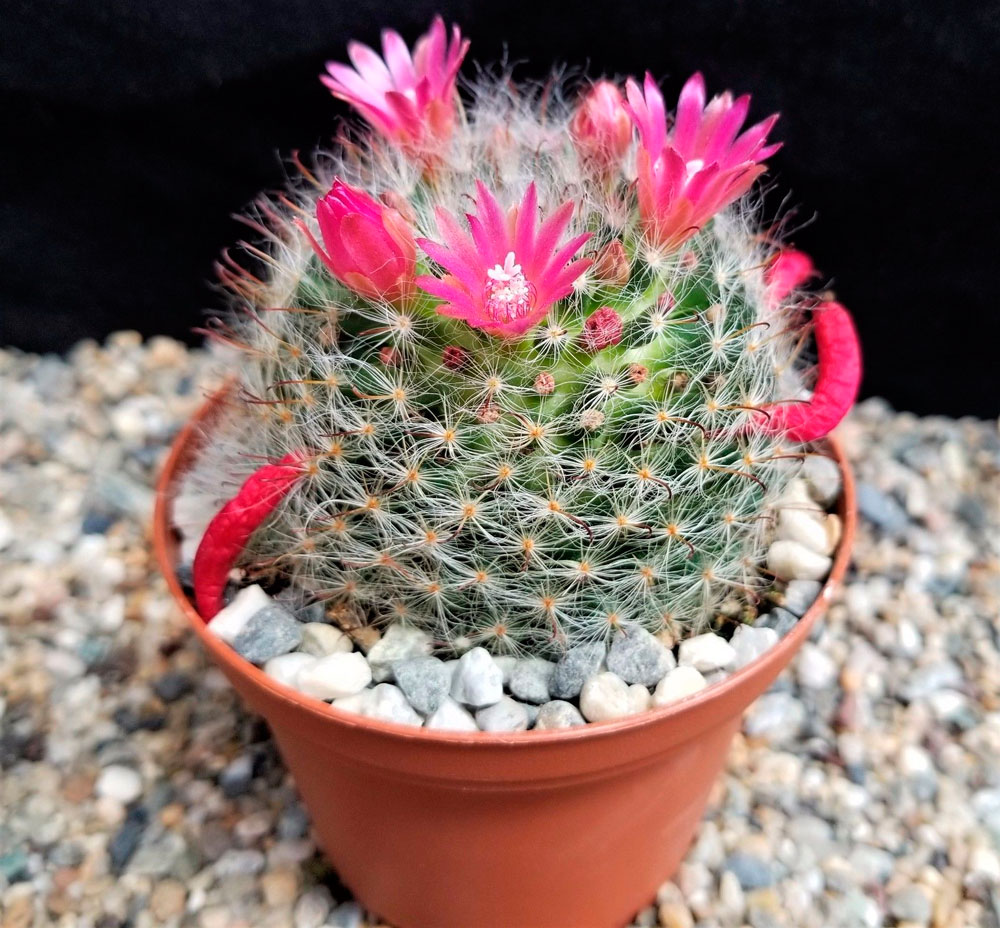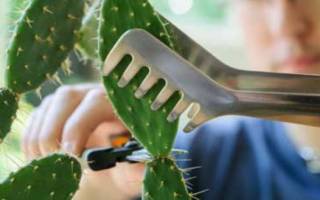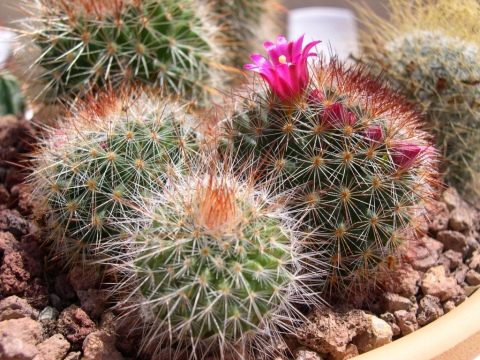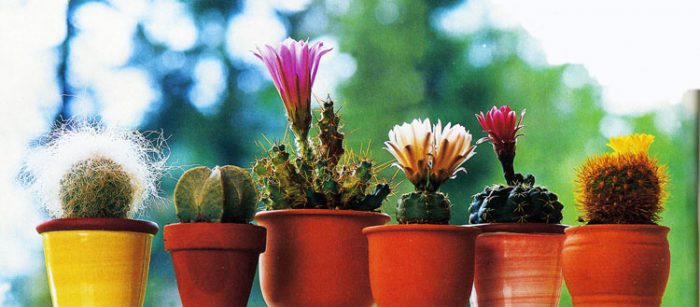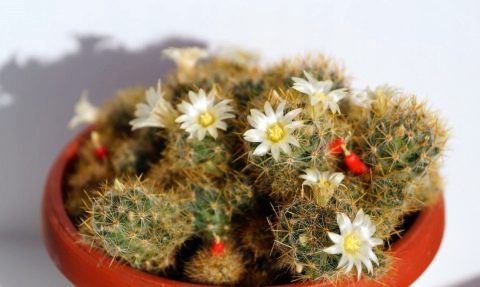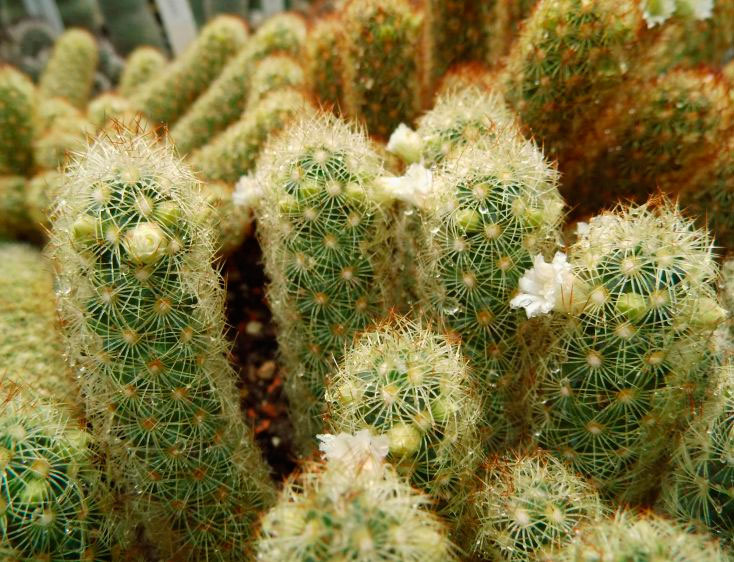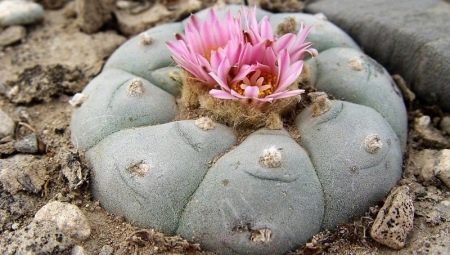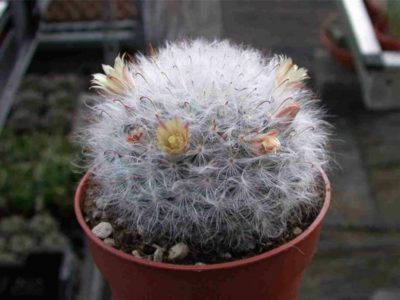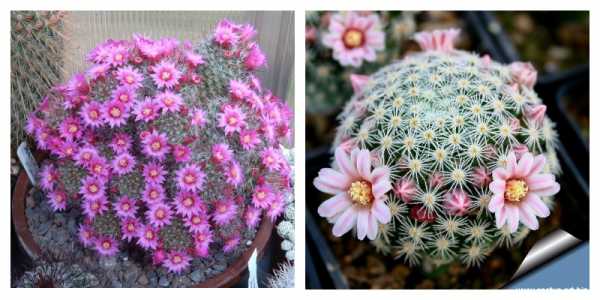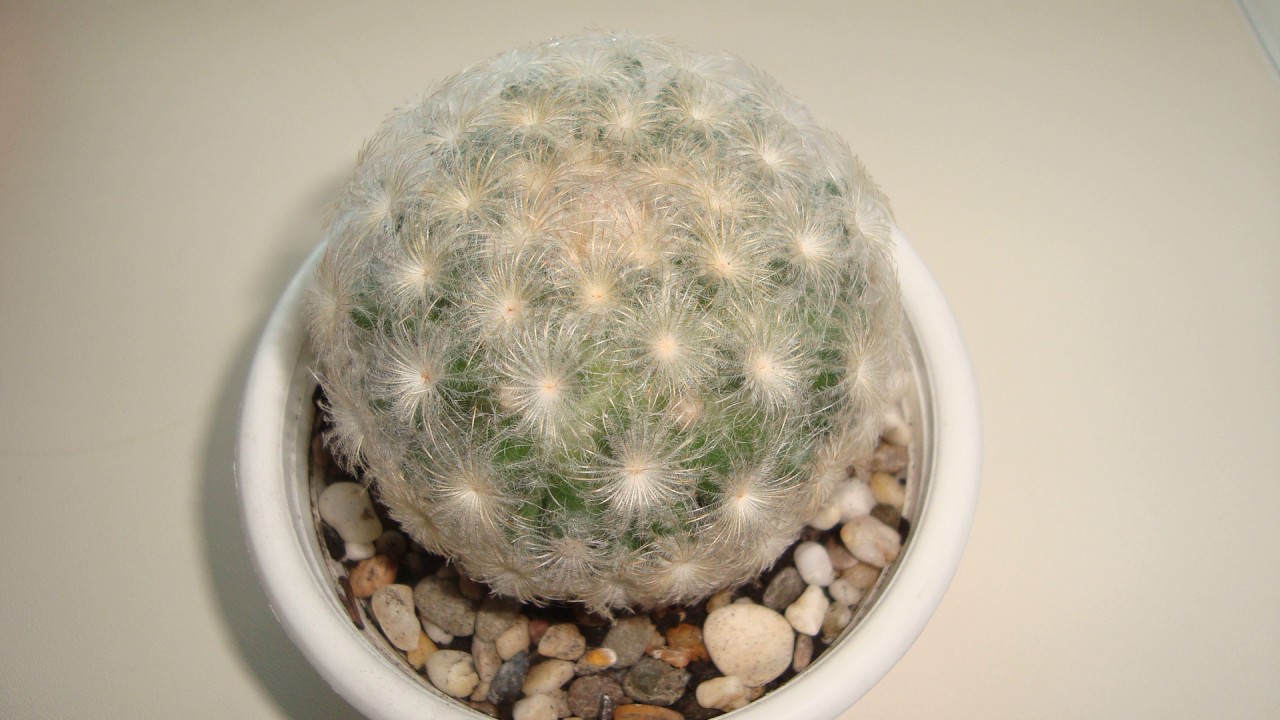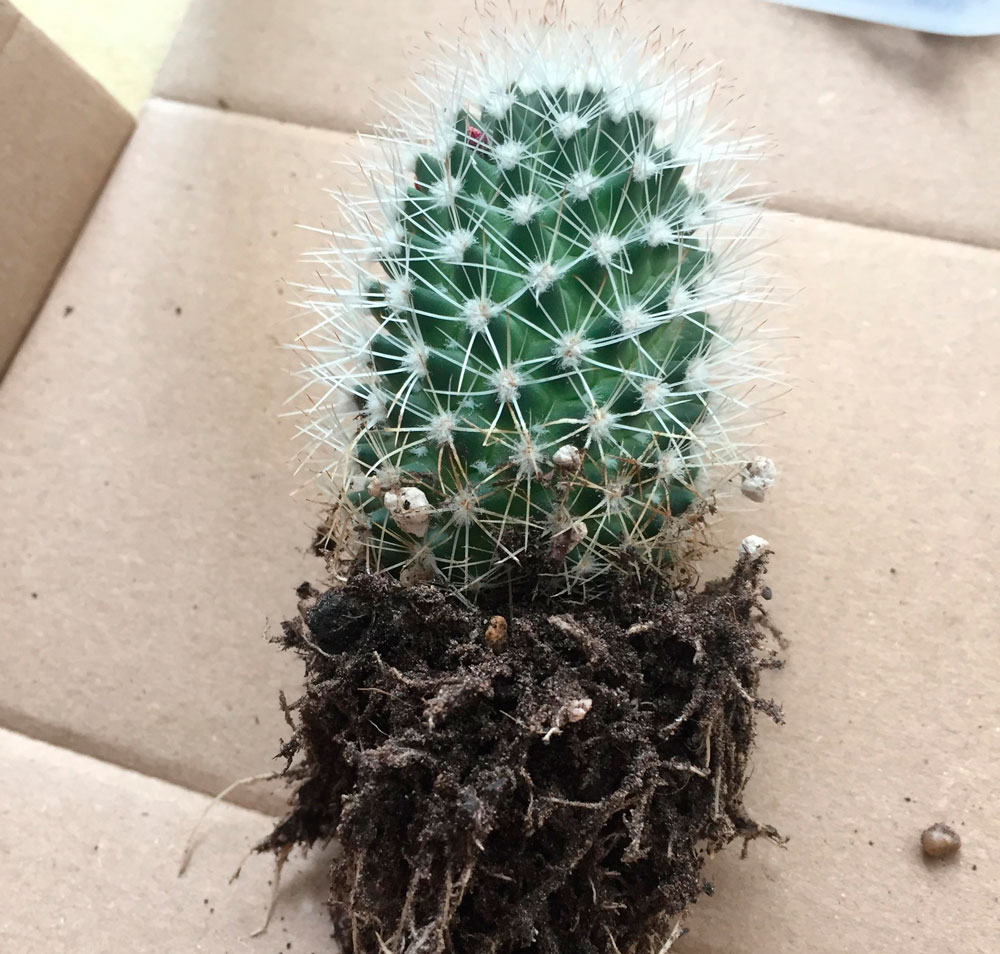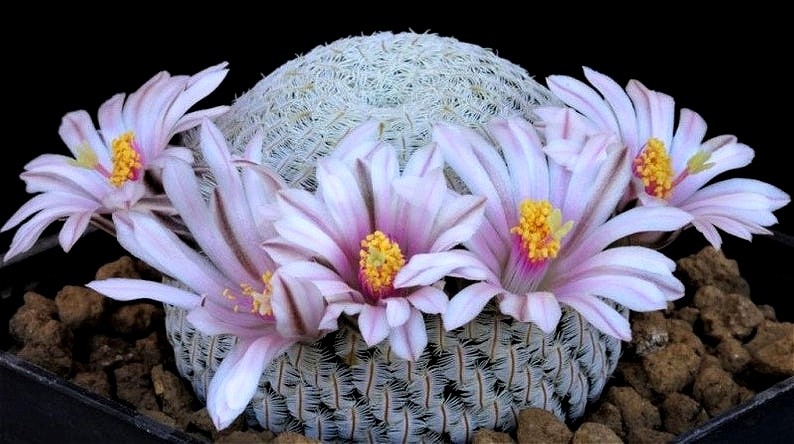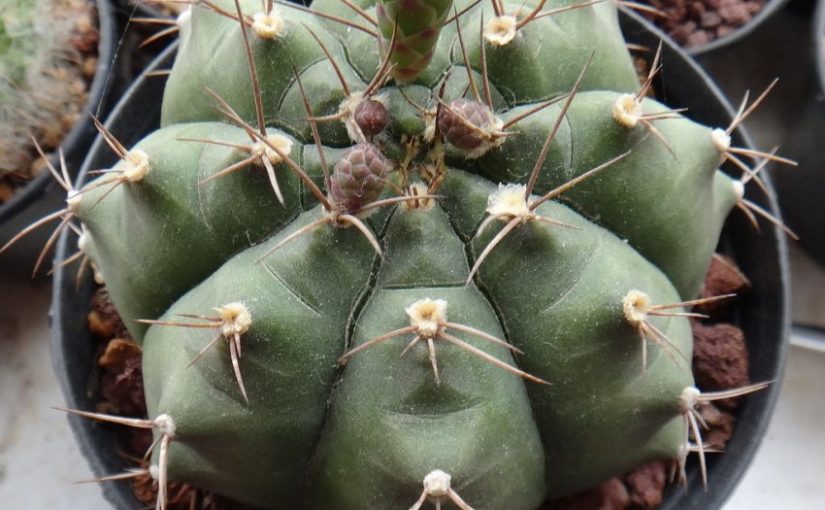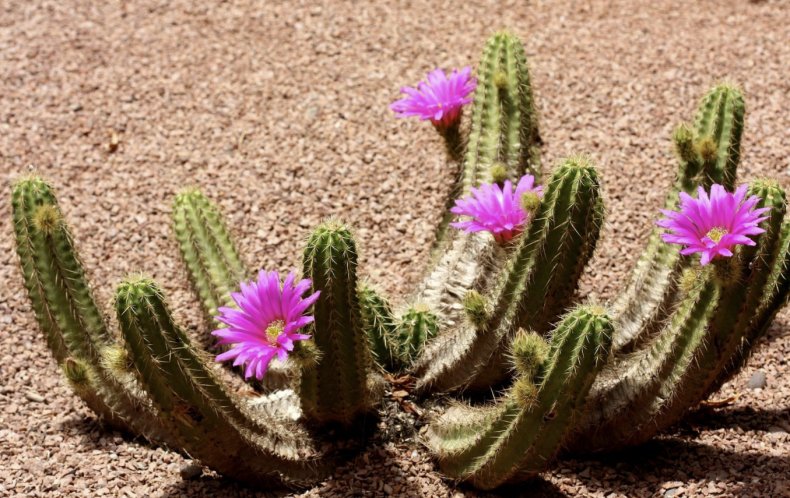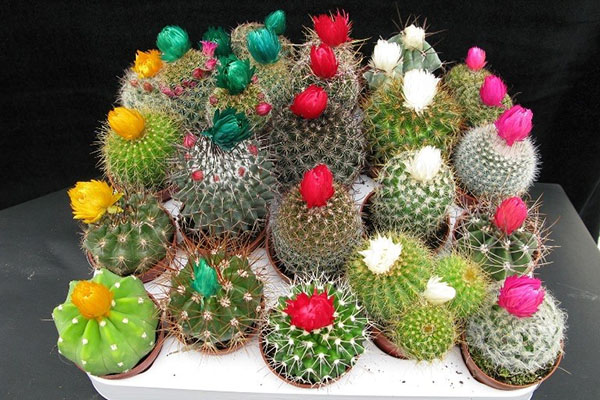Bloom
Cactus blooming is a very interesting and beautiful process, but, unfortunately, not everyone can enjoy it. There are people in whom the plant has been living for many years, but they have never seen its flowers. Then, they ask questions:
- Why isn't the cactus blooming?
- How to make a cactus bloom at home?
There may be several reasons, but in most cases it is improper care of the plant.
- It must be remembered that during the dormant period, the cactus should not be disturbed, just water it as described earlier and do not touch it again. Even a simple transfer from one place to another at this time can ruin everything.
- Another reason is non-compliance with the conditions of detention, namely, lack of light and temperature conditions. Check that all requirements are met.
- Bad soil, which has long been deprived of all useful and nutritious substances, can also prevent the plant from blooming. In this case, it is necessary to carry out a transplant and always, in a new, slightly larger pot.
- Well, the last reason is age and type. Flowering very much depends on the type of cactus and its age. As a rule, the first flowers on a plant can be seen not earlier than after 3-5 years, and in some species even after 10. But, it should be said that there are such specimens that can please you already in the first year, therefore, before than to panic, read about your "friend", when and at what age, you should expect the first flowers from him.
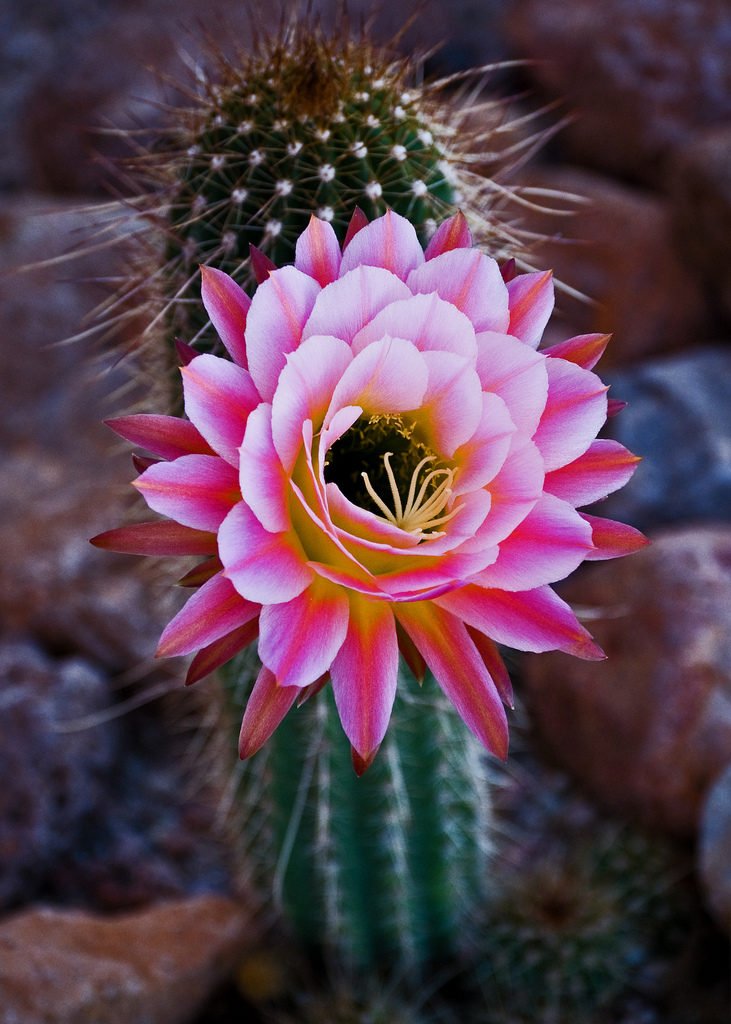
However, what to do if all the conditions of keeping are met, the soil is always good, watering according to the schedule and even the age of the plant is more than 5 years, and there has been no flowering yet? In this case, all that remains is to wait, perhaps the time has not come yet.
What else you need to know about flowering - how often does a cactus bloom?
Usually, this happens once a year, but in some species, there have been cases when flowering took place in the spring, and then again in the fall.
How many days does a cactus bloom?
Again, it all depends on the species and variety. For some, it is 10 days or more, for others, only 1 day, everything is different here.
How the Mammillaria cactus blooms
These succulents are in every collection I know, and, obviously, no beginner cactus grower will pass them by. These cacti are widely used in indoor floriculture.
All Mammillaria are united by the presence of papillae - tubercles, at the top of which is the lower part of the areola with spines, and in the sinus - its upper part, from which flowers and lateral shoots appear. Mammillaria blooms, as a rule, in a circle: in most species, small flowers are arranged in a ring around the top of the stem. The flower corolla of this succulent is very beautiful. All other characters are extremely diverse in different representatives of the genus. And according to the requirements for home care, Mammillaria cacti of different species are very different from each other.
Among Mammillaria there are real "tenacious", perfectly tolerating the numerous hardships of fate and mistakes of flower growers. But Mammillaria also includes some of the most difficult cacti in culture - even experts prefer to grow them in a grafted state. Therefore, buying a Mammillaria that you just liked or chosen from the picture is a risky game. It is imperative to first find out the main characteristics of the acquired species using the reference book.
Therefore, refrain from purchasing Mammillaria with large colorful flowers in the photographs.
Reproduction
Mammillaria cacti are propagated by children and with the help of seeds.
Children
You need to do the following:
Carefully separate the scion from the mature plant.It is best to carry out this operation with a sharp and disinfected knife.
Dry the baby under normal conditions for 2 days.
Prepare a small container, drop the baby off, put in a warm room, where there is no direct sunlight.
Be sure to water the baby after the transplant.
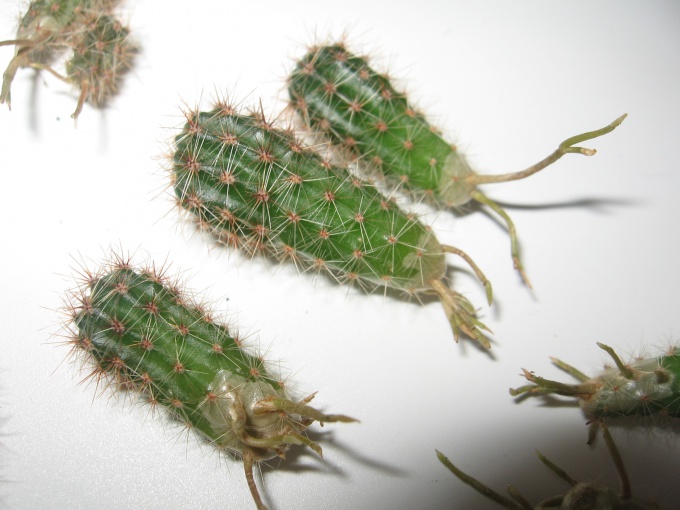
Cactus babies
Note! When a cactus is propagated by children, the cactus grower immediately receives a new plant
Seeds
In this case, you need to perform the following sequence of actions:
- Sow seeds into prepared soil, sprinkle them and place in a warm place without direct sunlight.
- After emergence, the pot is transferred to the sun.
Pests and diseases: prevention and treatment
Perhaps the most common pest affecting cacti is the red spider mite. It is especially dangerous for non-pubescent species.
To prevent infection, the plant stem is treated with a brush soaked in alcohol. To combat the tick, insecticides are used (for example, a weak solution of Actellik), and the cactus must be treated with them for two to three weeks. 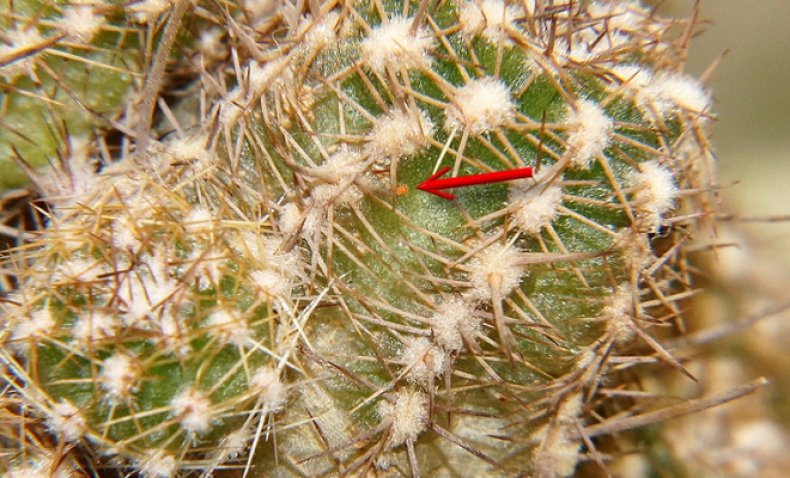 It will not be easy for an inexperienced cactus grower to recognize another pest, no less dangerous for mammillaria cacti - the cactus scale shown in the photo.
It will not be easy for an inexperienced cactus grower to recognize another pest, no less dangerous for mammillaria cacti - the cactus scale shown in the photo.
These are small insects (up to 2 mm in size), the body of which is covered with a wax shield. They fight them in the same way: they carefully wipe the stem with a brush moistened with alcohol, and when infected, spray it with insecticides.
Quite often, the roots of cacti infect root nematodes. The reason for their appearance is usually a poor-quality, infected substrate. It is very difficult to notice them, since they live in the root, and often they do not have time to save the plant. 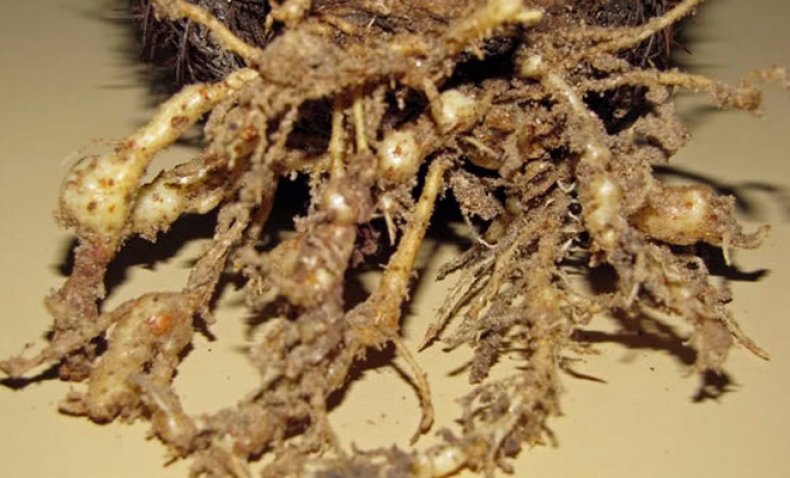 The part of the root on which the bubbles have appeared is cut off with a knife. Then the rest of the root is placed for 10 minutes in hot water at a temperature of about 50 ° C (you must avoid getting water on the neck of the root) and treated with charcoal.
The part of the root on which the bubbles have appeared is cut off with a knife. Then the rest of the root is placed for 10 minutes in hot water at a temperature of about 50 ° C (you must avoid getting water on the neck of the root) and treated with charcoal.
Important! To prevent root damage by nematodes, it is necessary to calcine the earthen substrate in the oven for an hour at a temperature of at least 150 ° C before planting the plant.
Composition from hymnocalycium Mix - description and care features
Gymnocalycium is an unusual home cactus with 80 or more species. The plant has decorative spines up to 4 cm long and unusual flowers. In appearance, Gymnocalicium resembles a royal cactus, and its flowers are much larger than the stem itself. By planting several varieties in one pot or box, you can achieve great compositions on the windowsill.
Description and photo
Gymnocalycium mix is a mixture of several species that coexist perfectly in one container. Gymnocalicium is native to South America, more specifically Argentina and Brazil.
The original home cactus does not require special care, which is why many growers grow it. Experienced growers recommend planting several types of plants together. They are perfectly combined with each other, which makes a beautiful composition of small cacti.
Japanese
On the basis of the previous species, breeders bred the Japanese species (Friedrich), which does not have chlorophyll and is interesting not even in flowers, but primarily in the bright color of the stem. To ensure life, such cacti are grafted onto the stock. The stem is spherical, gives pink and purple flowers.
André
Differs in unusual color and very interesting appearance. The stem is dark green, the flowers are collected in a bush and have a light yellow color.
Reductum
The surface of the plant is covered with straight thorns, the flowers are white or beige.
So that the plants do not interfere with each other during growth, they are planted at a distance of 2 cm from each other. As the cacti grow, they are transplanted into a larger pot than the previous one.
Pruning
Pruning is only necessary when the cactus starts to rot and needs to be urgently reanimated.
- Cut off any rotten areas.
- The plant is then left on the surface for several days.
- After this time, the hymnocalicium should be planted in a suitable pot.
Pruning is also used when grafting one cactus to another. Slices of the same shape and size are made on both plants. Then the cacti are connected and secured with an elastic band.
How to transplant?
Transplantation of adult plants occurs once every 2-3 years and only as they grow. Young cacti should be replanted more often - once a year. The diameter of the pot should be slightly larger than the previous one.
Carefully remove the cactus from the pot and rinse the roots with warm water.
Leave it on a dry surface for 1-2 days.
Then plant in fresh soil.
Important! The root collar should remain at the same level as in the previous pot
Children
The first way is simple:
- The lateral process should be detached from the main stem and dried within a few days.
- Then it is planted in moist soil, where it quickly takes root.
- If the children have roots, then they are immediately transplanted into a separate pot.
Reproduction of green "hedgehogs"
Almost every mammillaria breeds
children. But five to ten years pass, and such a plant degenerates (the stems of new babies are becoming thinner, the thorns are less common, the cacti themselves are more unintelligible).
Therefore, it is better to buy from time to time
plant seeds (or collect from your cactus) and grow new specimens.
This is done like this:
- In a bowl with holes at the bottom, take a mixture of turf and sand.
- Spread the seeds over slightly damp soil. Do not sprinkle them, the seed is too small.
- Germinate the seeds under a plastic sheeting, plastic lid, or piece of glass at maximum heat (22 to 25 degrees).
- Open the seeds often by letting air in and spraying them.
- We saw the seedlings - you can remove the lid.
- First, cactus babies are "born" bald. The sprouts began to grow thorns - this is a sign that the guys can dive into their own pots.
Planting in a permanent pot, transplanting
A good option
soil for plants:
- 1 share of turf soil (if the cactus is old, take twice as much);
- 1 share of leaf;
- 1 share of peat soil;
- 1 share of sand;
- some brick chips.
Take the pot in the form of a bowl: shallow, but wide. The more your species of mammillaria is inclined to build up babies, the wider you buy a vessel for the cactus so that all this “offspring” will fit.
You need to repot the plant every year while it is young. A large mammillaria can be disturbed with a transplant less often - once every two, or even three years. Moreover, this is not the most pleasant procedure for us - the cactus takes revenge with might and main for the invasion of its personal space, plunging a lot of thorns into our hands.
Popular types of Mammillaria flower
Next, you can see the photos and find out the names of the Mammillaria species, the most popular among cactusists.
Several representatives of the genus Mamillaria are widespread in household floriculture. Their common features: medium-sized plants forming dense bushes or tussocks, undemanding in culture, easily reproduced by children.
This Mammillaria easily blooms with numerous rather nondescript whitish flowers. Fruits are set only by cross-pollination.
Since each such young cactus soon, in turn, becomes covered with children, miniature thickets are formed.
Numerous spines - needle-like and hair-like - develop so strongly in sufficient light that they completely cover the stem. The central spines are golden yellow, the rest are whitish. The flowers are about 1 cm in diameter, dense, waxy, as it were. Beautiful oblong bright red fruits are formed without cross-pollination and decorate the plant for a long time. There are several known forms close to the described ones, differing in greater squat and the color of the thorns.
This Mammillaria does not branch so abundantly, but an adult plant with several large baby branches also forms a dense group. The flowers are inexpressive - small, cream. Fruits are tied only with pollination.
Description of the plant

From the point of view of botany, almost all representatives of the Cactus family do not represent anything special, one might even say that these are very primitive plants
Succulents with reduced leaves, dense tissues of which are adapted to accumulate fluid reserves - what could be easier ...
However, due to the variety of external forms, representatives of this family occupy a worthy place both in landscape design and in indoor floriculture.

The variety of structure, as well as the size of the shoots, the direction of their growth, the ability to branch, etc. led to the fact that the family has a kind of "analogues" of almost all representatives of the plant world, as well as several of their own forms, inherent only in Cactus
Simply put, the same anatomy and physiology of cacti is not at all an obstacle to their external diversity and unique, incomparable exterior.
Well, do not forget about another important property of these plants. Most of them have beautiful and bright flowers.
The trunk of a cactus is a fleshy body filled with water. Its sizes can be different - from 1 cm to 20 m. The leaves of the cactus are reduced and represent thin pointed branches of short length, called thorns. They grow out of areoles - small modified axillary buds.
In some species of cacti (Echinocerus comb, Hatior, Lophophora, etc.), thorns may be absent altogether. Others (for example, astrophytum ibex), on the contrary, have very long prickly shoots up to 7 cm long.
Flowers and fruits of a cactus have an original device: part of the flower, bud and fruit are at the same time part of the stem.

Areoles of unusual shape on tree-like varieties of cacti
The root system of the plant is also reduced and consists of a rod with several medium-sized branches. Sometimes it is 5-6 short roots. Only in large species is it similar to the branched root system of trees.
The homeland of all cacti is America, but thanks to man, they spread from there all over the world. Mostly cacti are thermophilic plants, but some species can climb far from warm places. The most extreme species, capable of withstanding relatively cold winters, are found in Canada and southern Argentina (latitude 57 ° north and 50 ° south, respectively).
In the environment of cactus growers, there is a conditional division of the family into three groups:
- desert
- forest
- indoor
Desert species can differ significantly from forest species and require different growing conditions. As for the rooms, everything is a little simpler with them: most of them are artificially bred by cross-selection and feel fine in the conditions of apartments and houses.
Typical representatives of desert cacti are:
- echinopsis
- echinocereus
- various echinocactus
- astrophytums
- prickly pears
- rebuts
- mammillaria
- etc.

Echinopsis is the most common home-grown desert cactus
All desert cacti are drought-resistant plants and can do without watering for up to six months. They are not afraid of sunburn, and in general, the more direct sunlight there is in the life of this species, the better.
The variety of forest cacti suitable for indoor cultivation is somewhat more modest. This is due to the fact that in the natural conditions of the wild, they grow on the trunks of other trees, and not everyone can be adapted to home conditions.
Typical representatives of home-grown forest cacti:
- ripsalidopsis
- zygocactus
- aporocactus lash-shaped
- epiphyllum
Unlike desert cacti, forest cacti, although they are light-loving, cannot stand direct sunlight. It is recommended to place them in partial shade, or use diffused lighting. These varieties, although they can tolerate drought, are not as long as desert ones.

Making a greenhouse with your own hands from a profile pipe and polycarbonate: a complete description of the process, dimensional drawings, watering and heating (Photo & Video)




